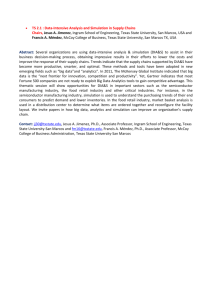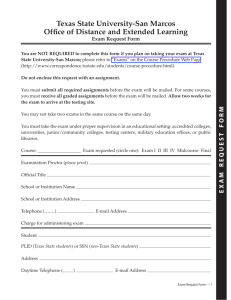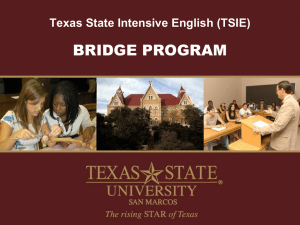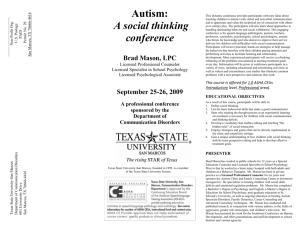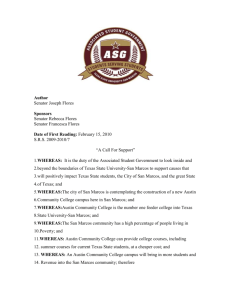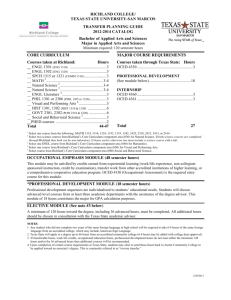Developing an Effective Call Center within the Financial Aid Office
advertisement
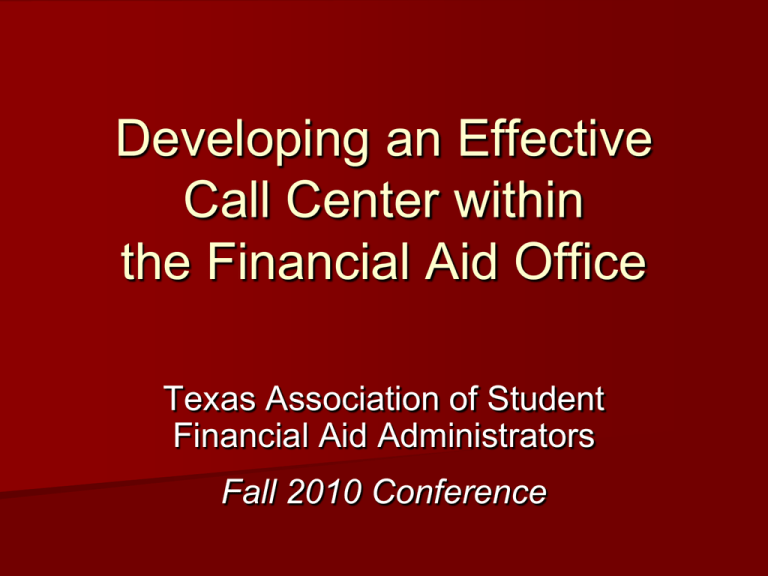
Developing an Effective Call Center within the Financial Aid Office Texas Association of Student Financial Aid Administrators Fall 2010 Conference Presenters Christopher D. Murr, Ph.D. Director Financial Aid and Scholarships Texas State University-San Marcos Anita Ford Supervisor Financial Aid and Scholarships Texas State University-San Marcos Purpose This session will focus on the process of creating a successful call center within the Texas State University financial aid organization to address effectively inbound customer calls and emails, while improving customer service and reducing staff stress. The session will address both the benefits and challenges of implementing a call center, as well as the related use of technology, quantitative measures, training and more. Overview Challenges to Customer Service Objectives of Creating A Call Center Organizational Change – First-Tier Customer Service Hedge-hogging in The Call Center Hiring the Right People Leveraging Technology Assessments Call Center Results Continuing Challenges of Operating A Call Center Future Objectives Challenges to Customer Service Callers during peak season waited as long as 45 minutes to speak with a financial aid representative Staff that answered calls also worked the service counter and answered office email Call supervisor lacked the ability to centrally track call, counter or email customer contacts Lacked staff and student accountability mechanisms Training took too long to allow staff to go live and be productive Suffered from high phone staff turnover Objectives of Creating A Call Center Focus select staff on answering calls Achieve a 70% (31.5 minute) reduction in caller wait time Achieve a 60% (3 minute) reduction in talk time Achieve a 90% good or excellent rating for phone advisors on customer satisfaction survey Provide phone team with the tools and training necessary to be successful Increase staff and customer accountability Reduce training time for new staff by two months Reduce phone staff turnover Previous First-Tier Customer Service Organizational Structure Phone and Counter Supervisor Counter – FA Assistant Phone – FA Assistant Counter – FA Assistant Phone – FA Assistant Phone – FA Assistant Revised Organizational Structure Call Center Supervisor Phone Advisor Phone Advisor Phone Advisor Phone Advisor Phone Advisor Phone Advisor Hedge-hogging in The Call Center Removed secondary duties from call center supervisor Focused advisors on answering phones Centrally located phone team staff Reduced incoming financial aid emails, which phone advisors answer, by 90% Limit review of lists and other tasks to those activities that can be performed in a multi-tasking environment Staff read such books as Good to Great Hiring the Right People Hire potential phone advisors through temporary agency (allows for evaluation period) Focus on hiring those with previous call center experience Assess learning and ability using a 100 question assessment instrument Raised base salary by 10% to a level comparable to financial aid counselors Leveraging Technology Phone recording and screen capture software Financial Aid Answer Bank – reducing email inquiries Online call tracking and unresolved issues application log Integration of call and lobby (walk-in) tracking systems Developed online document emailer applications for phone staff Developed online work lists for special programs and revisions Dual monitors Assessments Evaluation of phone recordings (formal and informal) Average talk time and wait time per phone staff member is a quantitative measure incorporated within his or her annual evaluation Knowledge tests (e.g., Title IV withdrawals) with supplemental training Call Center Results Successfully dedicated staff to answering inbound calls to FAS For 2008-2009, average wait time was reduced to 1:44 For 2008-2009, average talk time was 3:14 For 2008-2009, achieved a 96% good or excellent rating for phone advisors on customer satisfaction survey Successfully implementing technology to facilitate staff efficiency, effectiveness and job satisfaction Increased staff and customer accountability Reduced training time for new staff by two months Reduced phone staff turnover by approximately 40%—2 year attrition rate Continuing Challenges of Operating A Call Center Phone staff burnout Being too “Big Brother” Being too quantitative Keeping staff engaged during non-peak periods Reduce the feeling of being tied to the desk Keeping engaged with office Future Objectives Incentivizing performance on an individual basis Implementing a call board system Online scoring of phone calls More flexible scheduling (e.g., 4-day work week) Designing new work space geared specifically for a call center and the phone staff Making the job more fun Christopher D. Murr, Ph.D. Director Financial Aid and Scholarships Texas State University-San Marcos cm18@txstate.edu 512.245.3975 Anita Ford Supervisor Financial Aid and Scholarships Texas State University-San Marcos af24@txstate.edu 512.245-3633
